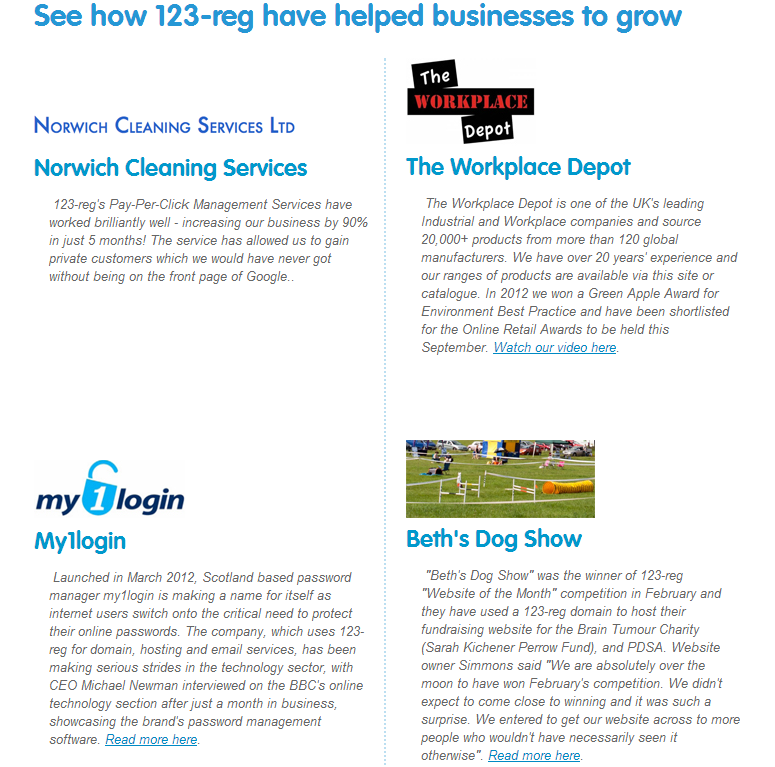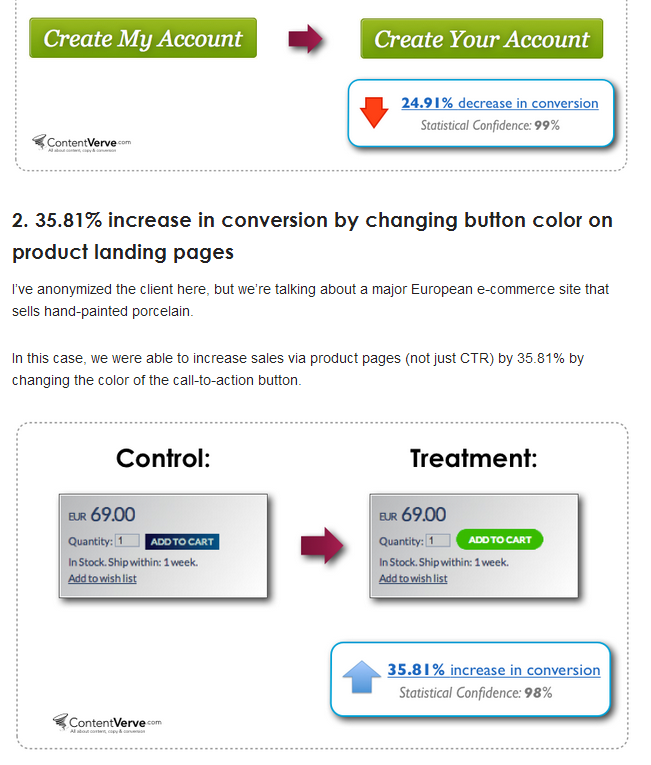The beginner’s guide to using case studies to build trust and make sales
Online advertising is a fantastic way to attract new customers, but it can be extremely hard. Trillions of display ads are shown to internet users every year. In fact, in one month you can expect to see more than 1,700 banner ads. Add to that the fact that click through rates stand at around 0.1% and it becomes clear that the online advertising battleground is a tough one.
Because of this, it’s important to diversify the tactics you use to convince potential customers that you’re the right business for them. Used properly a case study can not only bring you to the attention of people who are interested in the services or products you provide, but it can also help them understand the unique benefits your business can offer them.
Let’s look at how to create a case study.
Planning your case study
The most important thing to remember when creating a case study is that although the products and services you provide may form a significant part of what you talk about, your company should not be the main focus of the document.
It’s only possible to realise the full benefits of a case study if you abandon your ego and focus on other people. Done properly your case study should help people understand how your business can solve their problems. In turn, this will help people trust you, making it more likely they will buy from you.
Here are the required elements of a successful case study:
A good story – this will make the study easier to follow and help it resonate with people
Good design – You don’t have to pay a fortune, but the more attractive your study it looks, the more convincing it will be
Correct implementation – Understanding where and how to use your case study will increase its impact on potential customers.
Clearly this isn’t something you can consider doing as your first step in business promotion. You’ll need to have something of a track record before you can create a case study. After all it’s about showing people how you can solve their problem – something you can only demonstrate once you’ve done so.
This is what you need to do:
Find a willing participant
The first thing you’ll need is someone to take part in your study. Clearly, the ideal candidate is a happy customer. Other desirable attributes include:
- A significant social media following – this can help extend the reach of your joint case study.
- A strong story – if the company you partner with for your case study has a strong story, you’ll be able to create a more engaging case study.
- Finally, the participant you choose should be broadly representative of the customer base you’re trying to target.
Tracking down a case study participant should be relatively easy. If you’re already gathering customer feedback, you should have a strong idea of who your promoters are. Alternatively, keep an eye out for people saying positive things about you on social media or online review sites. If you’re used to doing business on a one-on-one basis, again, you’ll have a good idea of who will be interested in taking part. Once you’ve found a potential candidate, get in touch and explain what you’re planning on doing. Make sure you highlight the potential benefits to their business, as this will make it more likely that they’ll want to get involved.
Ask the right questions
Once you’ve found the right participant for the case study, you need to ask them the right thing. It may be tempting to ask questions like “why did you choose to do business with our company?” or “how has our company helped you?”. However, going down that route won’t yield the best responses. You need to ask questions that allow the respondent to really get to the bottom of why they chose to do business with you over one of you competitors.
Instead ask things like “What problem were you facing when you decided to do business with our company?” and “Can you explain how our product/service helped you solve that problem?”.
The answers you receive will be much more likely to resonate with readers and will ensure the case study doesn’t sound like an advertorial.
Show, don’t tell
Finally, don’t use your case study to repeat your sales copy or lecture readers about how good you are. The finished product should be the story of two businesses working together to achieve a desirable outcome, one that can be replicated by your potential customers if they do business with you.
Ultimately, your finished case study should:
- Feature relevant statistics
- Show clearly how your business has helped a customer
- Tell the customer’s story, not yours
- Be relatable and easy to follow
All of this can sound a bit vague in abstract, so here are a few examples of case studies that really nailed it and why.
Content Verve
This study by Michael Aagaard features the results of ten A/B tests he has conducted. Not only does he explain how he helped his clients, he tells readers how they can get the same results. It proves he knows what he’s talking about and demonstrates that he’s able to provide value. Note the use of images and how they make the study easier to follow.
The Brandwatch case study of its work with Kellogg’s is a good example of explaining how a product solved a particular problem, although it could do with putting more of a focus on the client.
Finally, this case study from Salesforce does an excellent job of convincing people that business to business social media campaigns are worthwhile.
Creating your case study
By this stage you should have the following things – a candidate for your case study, the questions you’re planning to ask them and a strong idea of what you want your finished case study to include. However, you also need to spend time thinking about how you want the case study to look and how you’re going to go about creating the finished product.
At the most basic end of things you can create a blog post and include all the relevant information – that’s the method used in the examples above. Alternatively, you could create a dedicated landing page or a PDF. You might even want to produce a hard copy of your case study.
When deciding what format you want to create your case study in, there are two factors you need to bear in mind.
The first is the manner in which your customers usually interact with you. If you’re running a digital-only business then clearly it makes sense to create a digital case study. However, if your customers expect to receive mailshots from you, you might want to consider a digital and a print version.
The other factor is cost – the more complex the design of your case study, the more expensive it will be. Unless, of course, you have the skills to do it yourself.
Although employing the services of a designer and/or copywriter might seem an expensive luxury, it can boost the effectiveness of your study and it doesn’t have to break the bank.
Here are some tips on getting value for money:
Services like Fiverr and 99 Designs are cheap, but they can produce good-quality end products. The key is to thoroughly vet people’s work to make sure it’s up to scratch. If possible, look at their past efforts as well as their proposal for your product.
If have a larger budget and decide to approach designers on an individual basis, make sure you get several quotes so you can judge what the going rate is.
Finally, view the case study as a long term investment – a good case study should have a lifespan of months, not weeks. That means that although you might have to spent money upfront, that investment will last longer than a traditional print advertising campaign, for example.
Making use of your case study
Once you’ve got the finished product ready to go, you need to make sure you get the best possible value from it.
Here’s what you should do:
Promote it via social media
Tweeting or Facebooking a link to your case study is a bare minimum. You may want to consider using paid promotion to help people find your case study. You can read our comprehensive guide to paid Twitter promotion here.
You should also make use of your existing network to ask them to share your case study on social media. The higher the quality of your case study, the more likely it is people will share it.
Using the case study to overcome buyer objections
Although promoting your finished case study is a good idea, the real strength of your case study lies in its power to overcome people’s objections to buying your product or service. For this reason you need to ensure that the case study is not only accessible on your website, but also accessible through the right parts of your website.
For example, there’s no point in emailing your case study to people who have just bought something from you – they don’t need any convincing. Nor is it a good idea to throw it in the face of people who have just clicked on your site for the first time – you’ll probably put them off.
Instead, concentrate on areas where people are considering buying your product, but haven’t made a final decision. Consider areas such as product pages, your about us page and your what we do page. If you use a registration system on your site, you can also send the case study to people who sign up but don’t make a purchase.
Finally, if you’ve got conversion funnels set up in Google Analytics, you can use them to identify points in the buying process that people are abandoning a purchase. Placing a link to the case study on pages where people abandon their purchase could help make sure people complete the sale. If you’re going to go down this route, make sure you run a proper test so you know exactly what the impact of the change was. You can learn the basics of A/B testing with this guide from Grasshopper.
Any questions?
You should now be ready to have a go at creating your own case study, but if there’s anything you’re not sure about just leave a question in the comments below and we’ll do our best to answer it for you.




